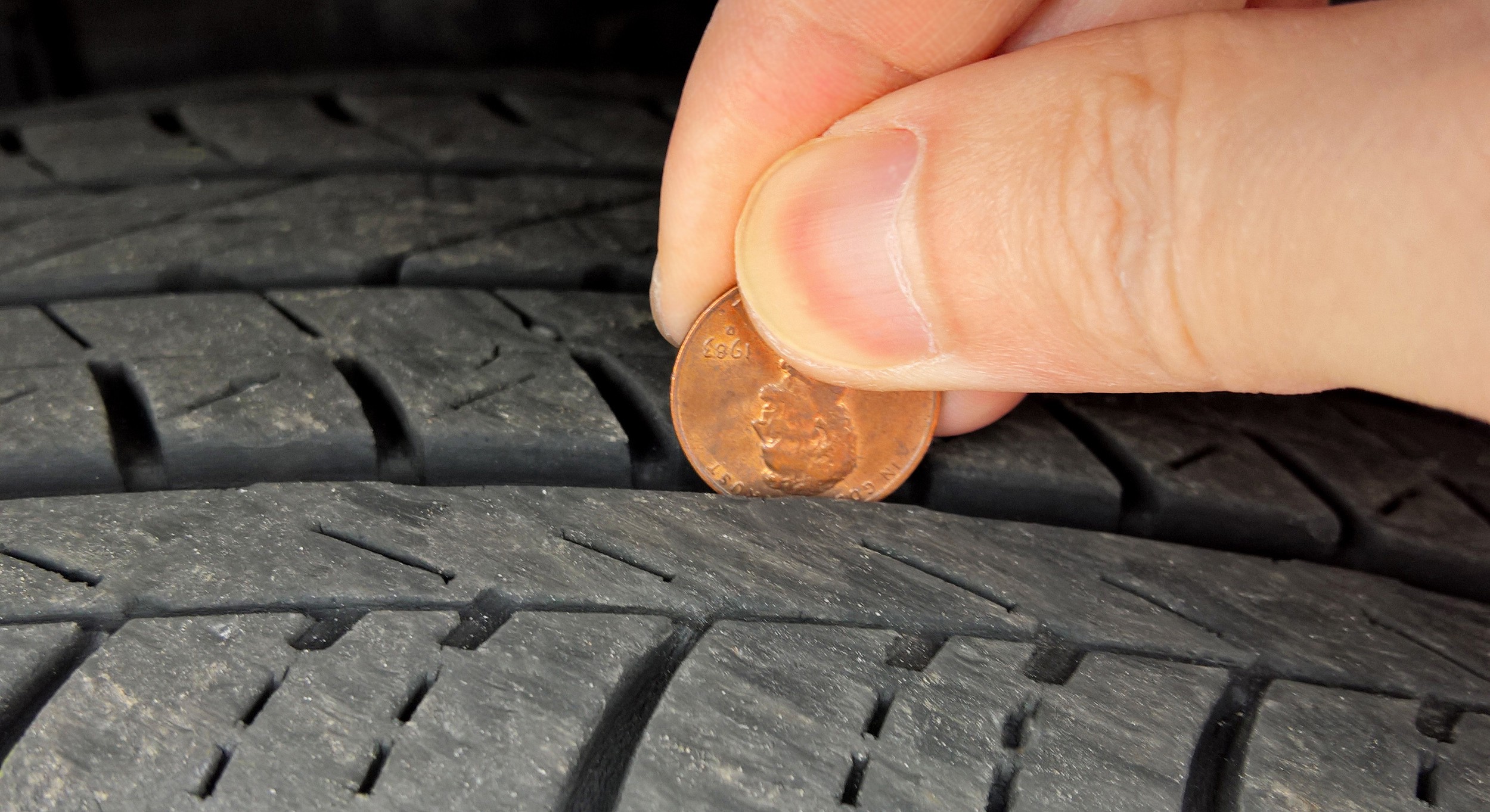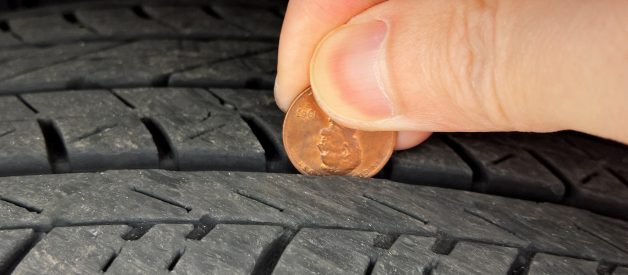By Michael Ailes
 The Tire Penny Test
The Tire Penny Test
Tires wear out. This much is true. But do you know how to identify when your tires are too tired to perform properly? If you are like many vehicle owners, maybe not. More than a third of drivers in the country cannot tell when their tires are bald. And studies have shown that ten to fifteen percent of vehicles on the road are running on at least one bald tire.
But what?s the big deal? Can?t you drive on bald tires?
Well, the short answer is ?sure, sort of? ? if you want to put yourself, your passengers, and everyone else on the road at risk. Tire performance declines as tires wear out, and significantly worn tires can make for dangerous driving.
Tire tread and traction
The tire tread that contacts the road is designed to maximize traction across a mix of driving conditions. Those tread grooves serve a purpose: to help your tires grip the road. With all of the safety features built into your car, truck, or SUV, none are more important than your tires, the only things between your four-thousand pound machine and the ground. Anti-lock brakes, traction control, and the like are of little value if your tires are not able to do their job.
Now, if you are a fan of auto racing, you will likely know that race cars on a track feature tires without tread. Racing ?slicks? provide more surface contact with the track in order to increase friction and traction. Unless you are racing on a dry, hot track ? or you live in a really arid environment ? you should not drive on slick or bald tires.. The truth is, while slick or bald tires actually show improved gripping performance on dry (and that means dry) pavement, that means nothing in most places, where drivers have to contend with rain or mud or driving in the snow.
When the road is wet, tires have a harder time maintaining traction, making acceleration, steering, and (especially) braking more difficult. Tire tread is designed to channel water away from the space between the tires and the road. This keeps more of the tire in contact with the ground and maximizes friction.
When tires wear down and the depth of the tread decreases, less water is diverted and traction decreases too. Reduced traction can happen once a tire gets to about fifty percent of its original tread depth, and it gets worse with wear. Acceleration on wet or slippery surfaces takes longer and the distance it takes when you hit the brakes on wet pavement increases, making it more difficult to stop ?in time?.
Even more, when you increase your speed, a condition called hydroplaning occurs. Hydroplaning happens when a layer of water builds up between a tire and the road surface. Instead of riding on the road, your car skims over the water. Unable to channel away the liquid, a worn tire will rise up on top of the water and will not respond to driver input (ie. steering and braking). The faster you drive, the more your tires hydroplane, and bald or worn tires hydroplane at lower speeds.
What is an unsafe tire tread depth?
Tread depth is measured in 1/32 inch increments. A new tire on a passenger car will have somewhere between 9/32 to 11/32 of an inch of depth in the large tread grooves. (There are also smaller grooves or slits in the tire surface. Called ?sipes?, these tiny slits help with traction in wet, snowy, or icy conditions). Once a tire wears down to 4/32? it is time to start looking for a new set, and by the time they reach 2/32?, they are considered completely bald. The measurement is made on the shallowest part of the tread. So if, say, the outside edge is worn down to ?bald?, but the rest of the tire is still good, sorry ? it?s bald.
Many states require by law that tires have more than 2/32? (3/32? in some cases), and a vehicle that has bald tires may not pass a state inspection.
To check the depth of your tires? tread, you have several options:
- First, you could perform the Tire Penny Test. Insert a penny into the shallowest part of the tread with Lincoln?s head in the groove. You should not be able to see the top of his head. If you can, your tires are bald ? less than 2/32?.
- If you?re a big spender, try the Quarter Test instead. With Washington?s head in the tread, you can determine if it is time to begin tire shopping. If the top of his head is buried in the groove, good. But if it is level with the edge, your tires are at 4/32? and ready to be replaced soon.
- Feeling really rich? Pick up a tire tread gauge at any auto parts store for a few bucks. A tread gauge will give you an accurate measurement of the tread depth. Remember to check at several places around the tire tread.
- Tires also come with built-in wear indicators, tiny little bars recessed in the tread grooves. When the surface of the tire is worn down to these wear bars, the tires are considered bald and need to be replaced.
- Finally, you can choose to have a professional at a trusted shop take a look for you. In addition to checking for tire wear, a repair shop can also perform other tire maintenance operations, such as tire rotation, tire balancing, and even a wheel alignment.
Other problems can signal a need to buy new tires besides tread wear. For instance, damage such as cuts or tears anywhere on a tire could mean it needs to be replaced. Same thing if you find a bulge on a tire. If you are driving and your steering wheel shakes in your hands, your tires could need to be wheel balanced, but they could also have a broken belt or separation and need to be replaced. Sometimes a misaligned suspension can cause tires to wear prematurely, especially on either the inside or outside edge. In that case, you probably need both a wheel alignment and new tires. When a tire wears unevenly (or significantly) pay special attention for any steel belts showing through the tread ? or where the tread used to be.
Some drivers ask if it is okay to replace tires in pairs rather than all four at once. If you neglect regular tire maintenance, such as tire rotations, your tires will probably not all wear out together. It is not uncommon for two tires to wear faster than the others, usually the front tires on a front-wheel-drive vehicle. While it may be best to replace in full sets (most all-wheel-drive vehicles require they be replaced in sets), you may be able to swap out a pair instead.
(See Ten Things You Should Never Do To Your Tires)
But don?t go with the common wisdom in that case, which suggests putting the new tires on the front. Put them instead on the back. When balding tires hydroplane in the front, steering becomes difficult, but at least your car wants to continue going straight. Slow down gradually and regain control. Hydroplaning of the rear tires, on the other hand, can cause a condition called oversteering, sending your car into a spin. So put your two new tires in back ? or replace all four.
In any case, whether your tires are old and going bald or they are relatively new and ready for rotation, make sure you have a relationship with a trusted shop for all your tire needs.
Riverside Automotive | Author: Mike Ales | Copyright March 2019
This article is intended only as a general guidance document and relying on its material is at your sole risk. By using this general guidance document, you agree to defend, indemnify and hold harmless Riverside Automotive and its affiliates from and against any and all claims, damages, costs and expenses, including attorneys? fees, arising from or related to your use of this guidance document. To the extent fully permissible under applicable law, Riverside Automotive makes no representations or warranties of any kind, express or implied, as to the information, content, or materials included in this document. This reservation of rights is intended to be only as broad and inclusive as is permitted by the laws of your State of residence.


